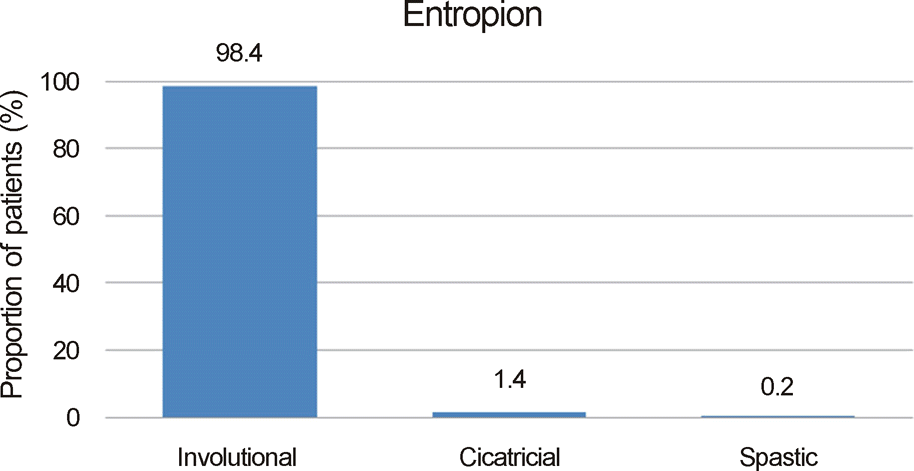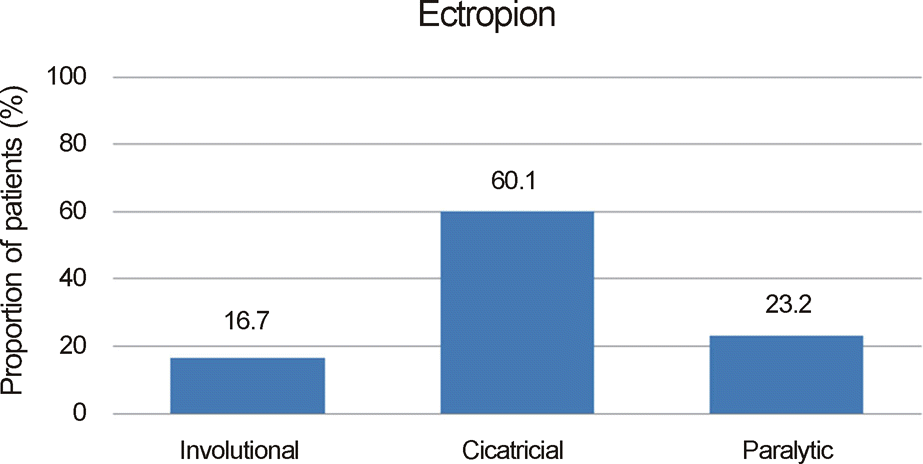Abstract
Methods
A retrospective review was performed of 397 patients (490 eyes) with entropion and 109 patients (138 eyes) with ectropion who underwent corrective surgery at Kim's Eye Hospital from January 2009 to December 2012.
Go to : 
References
1. Nesi FA, Gladstone GJ, Brazzo BG, et al. Ophthalmic and facial plastic surgery: a compendium of reconstructive and aesthetic techniques. Thorofare, NJ: Slack Incorporated;2001. p. 83–9.
2. Ha JK, Kim YS, Sohn MA. Surgical treatment of sensile entropion. J Korean Ophthalmol Soc. 1998; 39:631–6.
3. Jones LT, Reeh MJ, Wobig JL. Senile entropion. A new concept for correction. Am J Ophthalmol. 1972; 74:327–9.
4. Clarke JR, Spalton DJ. Treatment of senile entropion with botu-linum toxin. Br J Ophthalmol. 1988; 72:361–2.

5. Irvine S, Francis IC, Bishop AE, Baxter J. The entropion patch: a method of temporarily correcting involutional entropion with adhesive tape. Ophthalmic Surg. 1994; 25:604–6.

6. Kim JY, Kim YD. Surgical correction of senile entropion. J Korean Ophthalmol Soc. 1992; 33:1015–20.
9. Piskiniene R. Eyelid malposition: lower lid entropion and ectropion. Medicina (Kaunas). 2006; 42:881–4.
10. Maden A, Söylev MF, Ozkan SB. Acute onset transient ectropion associated with corneal ulcer. Int Ophthalmol. 1997-1998; 21:323–4.
11. Cheung D, Sandramouli S. Consecutive ectropion after the Wies procedure. Ophthal Plast Reconstr Surg. 2004; 20:64–8.

12. Caviggioli F, Klinger F, Villani F, et al. Correction of cicatricial ectropion by autologous fat graft. Aesthetic Plast Surg. 2008; 32:555–7.

13. Gupta B, Parmar B, Raina J, Chawla JS. Acute idiopathic bilateral lower lid ectropion. Indian J Ophthalmol. 2006; 54:212–4.

15. Liebau J, Schulz A, Arens A, et al. Management of lower lid ectropion. Dermatol Surg. 2006; 32:1050–6. discussion 1056-7.

16. Vick VL, Holds JB, Hartstein ME, Massry GG. Tarsal strip procedure for the correction of tearing. Ophthal Plast Reconstr Surg. 2004; 20:37–9.

17. Carter SR, Chang J, Aguilar GL, et al. Involutional entropion and ectropion of the asian lower eyelid. Ophthal Plast Reconstr Surg. 2000; 16:45–9.

18. Yun JK, Shim JC, Lee JH, Kim YH. Surgical results of inferior tarsotomy for diffuse lower lid trichiasis. J Korean Ophthalmol Soc. 2002; 43:1123–7.
19. Smith BC. Entroion. In : Nesi FA, Levine MR, Lisman RD, editors. Ophthalmic Plastic and Reconstructive Surgery. 2nd ed.St. Louise: Mosby;1998. chap. 12.
20. White WL, Woog JJ. Lower eyelid malpositions. In : Albert DM, Jacobiec FA, editors. Principles and Practice of Ophthalmology. NewYork: Saunders. 1994. p. 1845–50.
21. MELDRUM ML, TSE DT. Congenital eyelid anomalies, eyelid malpositions, and blepharoptosis. Interactive ophthalmology on CD-ROM-textbook and review. Baltimore: Williams & Wilkins;1997. p. 5191–326.
22. Bashour M, Harvey J. Cause of involutional ectropion and entropion–age-related tarsal changes are key. Ophthal Plast Reconstr Surg. 2000; 16:131–41.
23. Stefanvszvn MA, Hidavat AA, Flanagan JC. The histopathology of involutional ectropion. Ophthalmology. 1985; 92:120–7.

24. Chua J, Choo CT, Seah LL, et al. A 5-year retrospective review of Asian ectropion: how does it compare to ectropion amongst non-Asians. Ann Acad Med Singapore. 2011; 40:84–9.
25. Kim SY, Shin SJ, Yang SW, Han SH. Microscopic anatomy of the lower eyelid in Koreans. J Korean Ophthalmol Soc. 2006; 47:292–6.
Go to : 
Table 1.
Types of surgical procedures performed for entropion
Table 2.
Types of surgical procedures performed for ectropion
| Ecropion etiology (Number of eyes, %) | Surgical procedures performed (Number of eyes) |
|---|---|
| Cicatricial (83, 60.1) | Lateral tarsal strip operation (72) |
| Medial spindle operation (3) | |
| Lateral tarsal strip and medial spindle operation (4) | |
| Others* (4) | |
| Paralytic (32, 23.2) | Lateral tarsal strip operation (31) |
| Lateral tarsal strip and medial spindle operation (1) | |
| Involutional (23, 16.7) | Lateral tarsal strip operation (20) |
| Medial spindle operation (1) | |
| Others* (2) |




 PDF
PDF ePub
ePub Citation
Citation Print
Print




 XML Download
XML Download